Published
on 4
Jan 2018
|
All rights reserved.
|
|
|
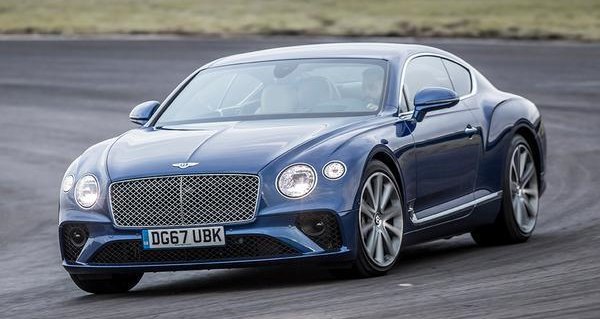
|
|
Weight
is not necessarily the biggest enemy to keen drivers, but weight at the
wrong side is.
|
|
The last Continental GT
was a mixed bag. It was tastefully styled and impeccably built,
smelling British luxury yet offering German reliability. On the
flipside, it was dull to drive – save the two Supersport models
perhaps. The problem was attributed to its underpinnings, which came
from Volkswagen Phaeton. That luxury limousine was a heavyweight, and
so was the Continental GT. For a 2-door, 2-plus-2-seating coupe, even a
luxury one, its 2.4 tons kerb weight was clearly over the top. Weight
is not necessarily the biggest enemy to keen drivers, but weight at the
wrong side is. The Conti employed a traditional Quattro 4WD system
which put its engine entirely ahead of the front axle. Although the
twin-turbocharged W12 was relatively short, it still needed to pack 12
cylinders and 6 liters of displacement, not to mention the turbos and
cooling system. As a result, the car had always been criticized for all
sorts of problems characterizing nose-heavy cars, i.e. understeer,
pitch under braking, low cornering limit, wooden steering feel, stiff
ride…
Having said that, the first generation Continental GT was a sales
success. Bentley built around 5000 to 6000 cars a year, accounting for
more than half the volume of the company during the period. In fact, it
was so successful that Crewe needed only a mild refresh to keep it in
production for 14 years.
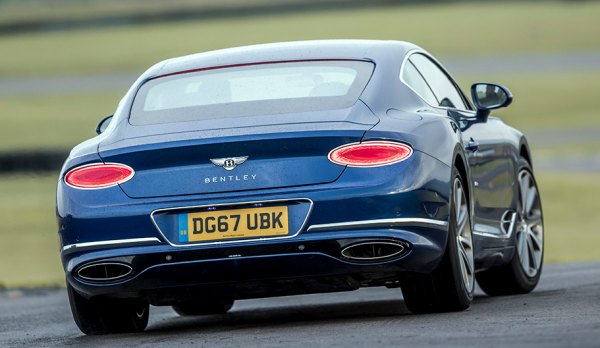
|
|
I
used to reckon Mercedes S-class Coupe as the world’s most beautiful
luxury GT. Now Bentley has toppled it.
|
|
Naturally, for the second incarnation, Bentley keeps its best element
intact: the beautiful profile. Again it combines sleekness with
classical sculpture. Meanwhile, the details get more elegant. The front
end is more sculpted, especially around the Jaguar-style headlamps. The
mesh grille gets lower, wider but more formal. There are more chrome
decorations at the sides, too. At the back, the tail gets even sleeker,
while the oval taillights and exhausts look far more elegant than the
old ones. I used to reckon Mercedes S-class Coupe as the world’s most
beautiful luxury GT. Now the new Bentley has toppled it.
Inside, the new cabin has its design overhauled. Its dashboard is not
quite as sculpted as the old one thus it is no longer that special.
However, the craftsmanship and use of materials are still excellent,
whereas electronic technology is markedly improved, expectedly. Above
the center console is a 12.3-inch touchscreen. It is actually part of
the 3-face rotary device, which can be transformed to a traditional
wood panel or 3 analogue gauges showing insignificant information
(outside temperature, compass and timer). It sounds flamboyant to me,
but its target customers might love that. Ergonomics is improved by not
only the touchscreen but also the sloping center console, which makes
the controls easier to see and reach. Compared with S-class Coupe, the
Bentley’s interior still looks more bespoke and expensive due to its
heavy use of wood and chrome. It meets your expectation for what a
British luxury car means. On the downside, the two rear seats are still
suitable only to children or at most short adults for a brief ride, as
it lacks both head and legroom. Fortunately, the boot is big, which is
critical to a cross-country GT.
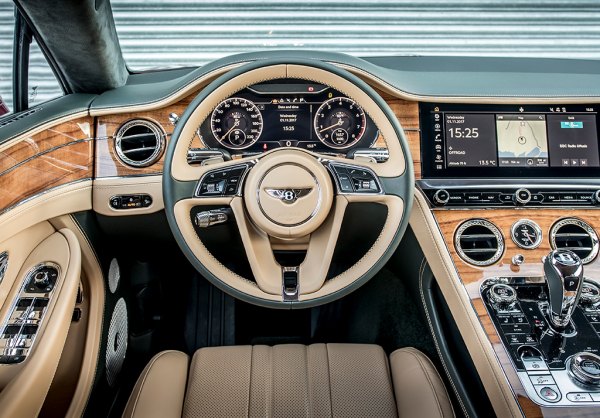
|
|
Compared
with S-class Coupe, the Bentley’s interior still looks more bespoke and
expensive.
|
|
The new car is almost the same size as the old one. Its body length is
kept unchanged, though its gets 11mm wider and its wheelbase is
stretched by 110mm, thanks to reduced front overhang. This new
proportion is made possible by the switch to the Porsche-developed MSB
platform, which is already used by Panamera. (BTW, Bentley is now
managed under the Sport/Luxury group headed by
Porsche, so a lot of components and development come from the latter.)
The MSB has its front axle pushed forward by 135mm, so the engine sits
closer to the firewall, and the front driveshafts have to run through
the bottom of the engine sump. Weight distribution is therefore
improved from 56:44 to 53:47 for the W12-engined model (the forthcoming
V8 should be better still). As in Panamera, the new 4WD system uses a
multiplate clutch to engage the front axle on demand, so in normal
driving the car is largely rear-drive. Hopefully this will greatly
improve the car's handling and feel.
Unsurprisingly, the car’s body-and-white chassis is built at Porsche’s
Leipzig plant alongside Panamera. It is then shipped to Crewe for final
assembly and trimming. The chassis is a mixture of steel and aluminum,
while the entire bodywork is made of superformed aluminum sheets. The
body-in-white is 80kg lighter than the old car's steel construction,
while the whole car is 76kg lighter. Even so, it still weighs some 2244
kg, or 239 kg more than its arch-rival Mercedes-AMG S63 Coupe 4matic.
The Panamera-sourced suspensions consist of double-wishbone up front
and multi-link setup at the rear, supplemented with 3-chamber air
springs, continuous adaptive dampers and 48V motorized active anti-roll
bars. Its technology is certainly state of the art.
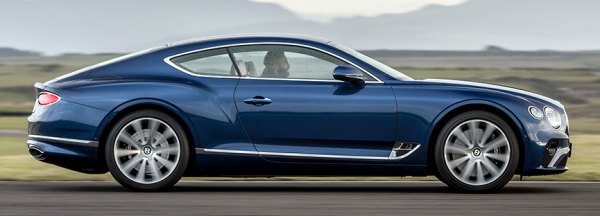 |
|
The
MSB has its front axle pushed forward by 135mm, so weight distribution
is a lot improved.
|
|
The new W12 engine already debuted on the Bentayga SUV. It looks like
the old one on paper, but it has some important new features, most
notably cylinder deactivation (which shuts down half the cylinders on
light load), direct and port injection and automatic stop-start. These
help it reducing fuel consumption by 16 percent, although its CO2
emission of 278 g/km is nothing to be proud of, considering the
similarly powerful S63 Coupe 4matic is good for 211 g/km. The W12
produces 635 horsepower and a mighty 664 lbft of torque from merely
1350 rpm all the way to 4000 rpm. It guarantees a top speed of 207mph,
and 0-60mph can be achieved in 3.6 seconds. Although the lighter
Mercedes is faster still against stopwatch, I wonder if anyone would
feel the Bentley slow. Moreover, it follows the Panamera to adopt an
ZF-built 8-speed twin-clutch gearbox instead of torque-converter
automatic that almost everyone else in the luxury world employ. This
should make it feel more responsive.
On the road, the W12 makes slightly throatier noise than the old one,
but it is still not as musical as its V8 or V12 rivals on the market.
However, it does feel torquey anytime, anywhere, thus the Continental
GT is very quick in a straight line. Do we want a Supersport version?
Well, it wouldn't hurt to have more power, but the emphasis should be
shifted to better sound and less weight. At this moment, the Achilles’
heel is the twin-clutch gearbox, at least on the pre-production cars.
Its gearshift is occasionally clunky or hesitant at low speed
maneuvering. As Panamera has no such problems, for sure Bentley will
have it ironed out through fine tuning before reaching production.
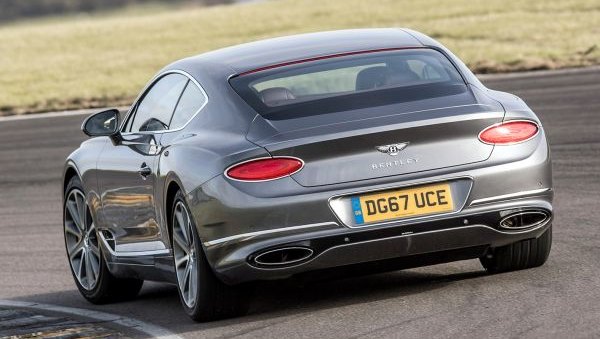
|
|
The
Conti finally becomes a driver’s car, more like a big Porsche...
|
|
However, the most transformed is handling. Drivers of the old car
wouldn’t believe how good it steers and corners. Although the car is
undeniably heavy – you’d feel it if compare with Aston DB11, it is
well balanced. Front-end grip is much enhanced. Understeer, roll
and brake dive are much reduced. This is not only down to the better
weight distribution but also the rear-biased 4WD. Even when the rear
wheels spin, it will send only up to 38 percent torque to the front
axle, or just 17 percent in Sport mode. As a result, the car feels a
lot more agile and neutral on the road. The steering is less corrupted
by torque thus feels more alive. On a wide open track, if you switch
off stability control, you can even induce big power slide at corner
exit. In short, the Conti finally becomes a driver’s car, more like a
big Porsche than “the world’s fastest
lorry”. Aston DB11 has tighter body control, higher agility and
adjustability still, of course, thus it is the car to have if you
prefer sport to luxury, but the Continental GT now seems to be more fun
to hustle than the S-class Coupe. That is perhaps most important to
Bentley.
Meanwhile, the better weight distribution, longer wheelbase and the
presence of
active anti-roll bars mean softer suspension setting can be used.
Moreover, the 3-chamber air suspension widens its versatility,
resulting in a superb ride comfort in "Comfort" and "Bentley" (normal)
mode. The Continental GT is finally a true GT, one that can be fast and
comfortable
over long trips, yet capable to deliver respectable cornering prowess
and thrills if you want. Most important, it ticks all
the boxes customers care: style, luxury, build quality and sense of
occasion. The only thing less outstanding is the W12 engine, which
makes the forthcoming V8 more promising. Anyway, good job Bentley and
Porsche! This is the most transformed car in last year.
|
Verdict:      |
Published
on 14
Feb 2020
|
All rights reserved.
|
|
Continental GT V8
|
|
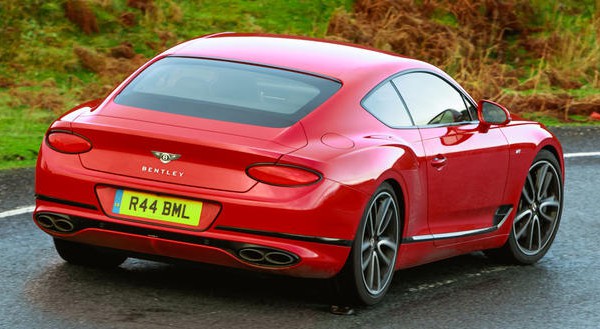
|
|
Lighter
and more agile, the V8 is choice of any one unconcerned of badge.
|
|
In the last generation
Continental GT, we found the V8 model much better than the flagship
W12. It was not only cheaper but also lighter, better balanced, more
agile, and its V8 sings better than the W12. It was a classic example
of “less equals more”.
The same story can be found on the new Continental GT. As much as we
admire the W12’s new found dynamics – remember, it is now based on the
Porsche Panamera platform, has its engine positioned much further back
and the
drive goes mostly to the rear axle – less weight and more agility would
not go amiss. Replacing the 6-liter W12 with a 4-liter V8 saves 50 kg
over the front axle. This makes the big Continental GT keener to turn,
more precise to place, especially on twisty mountain roads. The
modifications to chassis are kept to the minimum, just retuning the
suspension to
deal with the altered load, but the V8 seems to afford more grip and
offer a bit more communication through the steering.
No, on a mountain road it is still no match for Aston DB11,
which is sharper and more agile still, but for a car this big and heavy
(some 2.2 tons before load), this luxury and impeccably built, you
can’t help amazing how it controls its mass so well. The only weakness
is brakes, which is marginal for its mass and speed.
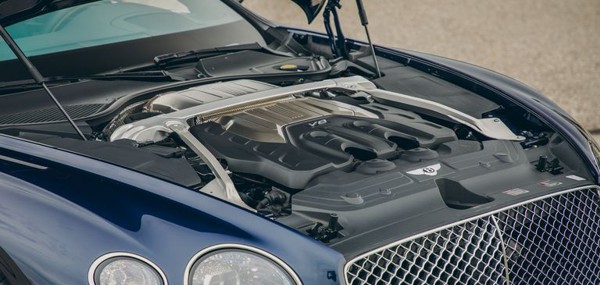 |
|
The
V8 offers less punch than the W12 but the noise it produces is way more
charismatic.
|
|
The price gap between the V8 and W12 is not that vast, i.e.
£149,000 vs £160,000, but the performance gap is also quite
narrow. Bentley claims it goes from 0-60 in 3.9 seconds, 0.3 behind the
W12. Top speed is just under 200 mph, down from 207 mph. In real world
driving, you won’t notice such a slim difference. Instead, you will
notice the classic rumble of the V8 at low revs, or its thundering,
charismatic exhaust note at full song. The W12 has always been
criticized for underwhelming sound. It has the same cylinder count as a
V12 but not the same sound quality. Being quiet and smooth, it is a
good engine for a
limousine but not something a grand tourer deserves. The V8 is the
answer.
Like the last generation, the 4-liter V8 comes straight from Audi
(although not that different from Porsche’s), featuring hot-Vee
architecture, a pair of twin-scroll turbos and cylinder deactivation,
but it gets its own, louder exhaust. It is rated at 550 hp and 568
lbft. You might notice that Audi is able to
extract more on its own applications (RS6 gets 600 hp and 590 lbft), so
Bentley is probably holding something for the next V8 S or GT3-R.
However, even at current state, the Continental GT V8 is still fast
enough. The V8 also works brilliantly with the Porsche-sourced 8-speed
dual-clutch gearbox, which is smooth, responsive yet cleverly
programmed. More important, with the new car's much better chassis
balance and active 4WD system, its speed is much easier to access.
While the W12 is slightly overwhelmed by the engine, the V8 achieves
the better balance between power
and control. It feels a more complete product.
|
Verdict:      |
Published
on 12
Sep 2021
|
All rights reserved.
|
|
Continental GT Speed
|
|
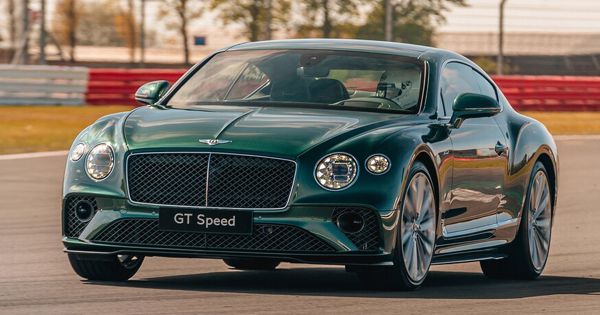
|
|
Speed
is not just about straight line speed. It corners better than any other
Conti.
|
|
Among all performance
luxury car makers, Bentley is probably the most committed to electric
future. By 2026, it will build only plug-in hybrids and electric cars.
By 2030, all will be the latter. In other words, only 5 years is left
for pure combustion models like the Continental GT Speed. You had
better to enjoy the best of the time and the worst of the time.
The Speed label was used also in 2007 and 2012. Excluding the special
edition Supersports, it represents the fastest Continental GT. The new
car is no exception. Derived from the W12 model, its engine is uprated
by 24 horsepower to 659. Maximum torque is unchanged at 664 lbft, which
is also the torque capacity of the 8-speed dual-clutch gearbox. On the
road, you might not notice the extra power, as the car is only a tenth
quicker to go from 0-60 and merely 1 mph faster on Autobahn, but we are
talking about some astonishing figures: 3.5 seconds and 208 mph.
The Continental GT has never been short of straight line speed, but
even the current generation is much better balanced than its
predecessor, more agility won’t go amiss for a car weighing 2.3 tons.
To that end, Bentley gives
the Speed a couple of new technology: rear-wheel steering and active
differential. The former should make it more maneuverable at tight
corners and more stable at fast bends, while the latter lets the car
manages oversteer and wheel spin more precisely. These new devices let
the engineers to adopt a faster steering ratio and a more adventurous
tuning to the stability control, allowing more oversteer before
intervention. Similarly, the 4-wheel-drive system has been reconfigured
to be more rear-biased in Sport mode, sending no more than 30 percent
torque to the front axle in any conditions. As a result, the Speed
feels sportier, more agile and more eager to turn. Understeer still
occurs when entering a fast curve, but you can push the tail out with
throttle readily, and progressively. Such a benign manner is quite
astonishing for a car so big and heavy.
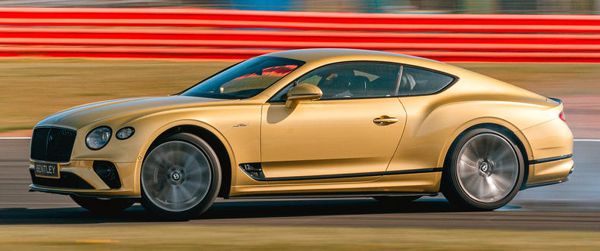
|
|
4WS
and e-diff allow it to adopt a more adventurous tuning.
|
|
Besides, the Speed is available with the largest ceramic brakes in the
world: the front discs measure 440mm, clamped by 10-piston calipers and
run inside massive, 22-inch wheels. This option saves a valuable 33kg
of
unsprung weight and offers track-worthy braking performance, although
some road testers found the brake pedal feels slack at its initial
travel.
The 22-inch wheels might return more road noise and don’t tolerate
harsher surfaces as well, but otherwise the 3-chamber air suspension
and motor-powered active anti-roll bars are quite effective to keep its
cornering flat and ride agreeable. Buyers won’t find much to sacrifice.
The graceful look, the impeccable interior, the creature comfort and
refinement of other Continental GT models are kept. It is not a Ferrari
or Aston, but then again no one blends luxury and performance as good
as the Bentley.
|
Verdict:      |
Published
on 30
Jun 2023
|
All rights reserved.
|
|
Batur
|
|
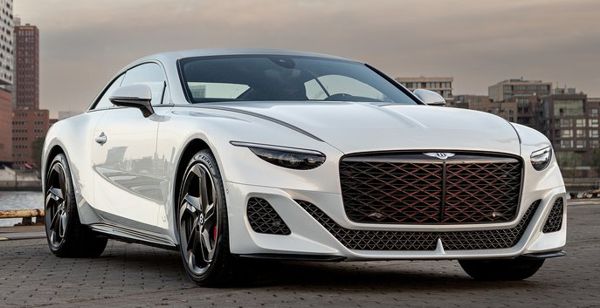
|
|
Batur
previews the styling direction of next gen Bentleys while say goodbye
to the W12 motor.
|
|
A couple of years ago,
Bentley’s coachbuilding division Mulliner built 12 special roadsters
called Bacalar out of the underpinnings of Continental GT. It cost
£1.8 million but, as expected, Bentley had no problem to sell
such a small batch. Now it repeats the same trick with the Batur coupe.
Price rises slightly to £2 million, as is the batch to 18 cars.
However, the Batur is more significant than the Bacalar in a few ways.
Firstly, its new design language – lower, sharper and sportier than the
existing Bentleys – previews the styling direction of the next
generation electric-powered Bentleys. Secondly, it is the last
incarnation of the 20-year-old Volkswagen W12 motor before its
retirement next year, so it gets an ultimate boost of power to make it
faster than any other Continental GTs, Bacalar included.
The Batur’s lower and squarer radiator is devoid of chrome. Its body
shape also lacks the strong sculpture of the Continental GT. Instead,
its waistline is an arc that runs seamlessly from nose to tail. It
appears lower, broader and smoother. The lower roof, slimmer headlights
and reshaped quarter windows add some lightness to the design, although
I think the Continental is still unparalleled in attention to details.
Windscreen is carried over from the standard car, but other exterior
parts are new. The roof, doors and bonnet are obviously made of
aluminum while fenders and quarter panels are carbon-fiber. This, in
addition to ditching the rear seats, cuts its kerb weight by 40 kg,
although 2233 kg is still nothing to be proud of, especially for a
2-seater.
The final incarnation of W12 engine receives bigger turbos, higher
flowing intake and enhanced intercoolers, lifting output to 740 hp and
738 lbft, or 80 hp and 74 lbft more than the next powerful Continental
GT Speed. It beats the last generation Continental Supersports by a
margin of 30 horsepower to be the most powerful Bentley road car in
history. As a result, 0-60 mph sprint dips by 2/10ths to 3.3 seconds,
while top speed inches up to 209 mph.
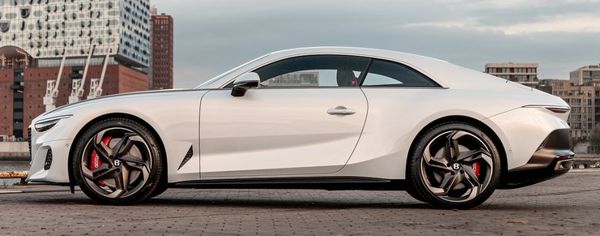
|
|
This
is the most powerful Bentley road car in history.
|
|
Despite the added thrust, it is not easy to tell on the road. The W12
remains well mannered – smooth and cultured, a true luxury car engine
but not especially memorable when you start to stretch its rev range,
which is limited to 6000 rpm. The noise is subdued and lacks the
character of the lesser V8. Is it really quicker than the Continental
GT Speed? Should be, but in the well-insulated cabin – unusually
well-insulated for a low volume project like this – your connection to
the road and speed is fairly distant.
Ditto the ride and handling, which is not that different from the
Continental GT Speed. Obviously, it gets all the most sophisticated
equipment to help it handle its considerable mass, such as active
anti-roll bars, eLSD and 4-wheel steering. Mind you, the lighter
Continental GT V8 remains more agile.
The Bentley is still a Bentley, not an Aston or Porsche. You buy it for
the luxury and bespoke interior it brings with its hefty price tag. The
Batur’s dashboard is certainly carried over from the standard car, but
it gets bespoke trims and display graphics, while some switches can be
3D-printed from precious metal. The choice of color and detailing
offered by Mulliner could be limitless. Is it 10 times better than the
standard car? I would say no, but money is just a matter of zeros to
the richest people in the world.
|
Verdict:     |
Published
on 16
Jan 2025
|
All rights reserved.
|
|
Continental GT Speed (hybrid) and 2024
udpate
|
|

|
|
Perfect
blend of hybrid power
|
|
Officially, this is the
4th generation Bentley Continental GT. However, like the 2010 model
that we skipped calling it the second generation because it was
actually a heavily modified Mk1, the 2024 car is also a development
from the existing model born in 2018. You can tell this easily from its
unchanged dimensions, familiar silhouette and much the same interior.
It is not a full makeover, but the work goes deeper than the usual
“facelift” from other car makers. In fact, Bentley said 68 percent
components of the car have been changed, most notably switching to a
400V electrical architecture that supports hybrid power for the first
time.
Yes, hybrid is the way to go in the foreseeable future of Bentley, as
full electrification is recently in doubt for luxury car segment.
Porsche
Taycan, for example, has seen sales dropped dramatically in 2024.
Bentley is more conservative than Porsche, so it is likely to stick
with plug-in hybrid power for longer, at least until the market
prospect of EVs gets clearer.
From outside the 2024 model differs from the outgoing car in only
design details, most obvious a pair of new oval headlamps. An LED light
bar crosses the headlamp and is referred to “eyebrow”, but frankly I
think the old car’s quad-headlamp arrangement looks far more elegant
and classier. Fortunately, Bentley keeps the rest of the sheet metal
nearly unchanged, which means still a perfect sculpture that no one
else in the industry can match, Ferrari Roma included.
The biggest news is the plug-in hybrid powertrain, of course. It
combines a 4-liter twin-turbo V8 with an electric motor that is
incorporated into the 8-speed dual-clutch transmission, accompanied
with a pretty large, 25.9kWh battery pack. The latter offers a
respectable zero-emission range of 50 miles (81km) and, if you
charge it up every time at home before driving, enables a CO2
emission of only 29 grams each kilometer. Hopefully that will help
Bentley to
comply with EU emission laws and avoid heavy fines.
Meanwhile, the PHEV powertrain is also way more powerful than the
outgoing W12 motor. With both power sources working in parallel, it
produces a staggering 782 horsepower and 737 pound-foot of torque,
exceeding the old Speed motor by 123 hp and 73 lbft. Moreover, boosted
by electric power, the torque curve gets much flatter, working a lot
stronger from low revs. As a result, 0-60 mph is cut by 4/10ths to
merely 3.1 seconds according to Bentley. Car and Driver even recorded
a hardly believable 2.8 seconds in its road test, a remarkable
achievement for a car weighing 2.5 tons. This is supercar territory!
Besides, the big Bentley is also one of the very few 200 mph-plus
production cars, topping 208 mph.
You might notice the PHEV powertrain is closely related to the one
adopted by Porsche Panamera Turbo S E-Hybrid recently, which is no
surprise as the Bentley shares its MSB platform as well. Like Porsche,
the latest incarnation of
V8 engine has ditched fuel-saving cylinder deactivation mechanism and
response-boosting twin-scroll turbos, because the electric power can
more than compensate the loss of both. Fuel injection pressure is
boosted from 200 to 350 bar to achieve cleaner emission, while
single-scroll turbos are easier to cut cold start emission. The V8
alone produces 600 hp and 590 lbft of torque.
Meanwhile, the electric motor inside the DCT offers another 190 hp and
332 lbft. It also provides torque-fill during gearshifts, helping the
DCT to achieve smoothness close to the torque converter automatics that
its rivals employ. The large battery is mounted under boot floor, so to
help the Continental GT Speed to improve its 53:47 weight distribution
to a perfect 49:51 (the lighter V8 also helps). This in turn allows
Bentley to dial back the front axle torque split and divert most power
to the rear wheels. As we shall see, this will have positive effect to
its handling.
Changes to the chassis is confined mostly to the suspension. As in
Panamera, it employs new 2-valve adaptive dampers which enable
independent adjustment of compression and rebound rates. The air
suspension is simplified from 3 to 2-chamber design. While the Bentley
does not offer Porsche’s game-changing active ride system, it still
gets 48V active anti-roll bars, active 4WD system, active rear
differential and 4-wheel steering as standard. Huge, 420mm front and
380mm
rear steel brake discs are clamped by 10-pot and 4-pot calipers,
respectively, while ceramic brakes are optional.
All these technologies add up to cost, of course. The Speed is priced
at almost £240,000 before options, making it more expensive than
its Aston or Ferrari rivals. However, neither can match the Continental
GT’s style, build quality or luxury.
On the Road
Most plug-in hybrid cars with a good battery size suffer from
considerable weight penalty hence poorer handling. This seems to be not
the case for the new Bentley Continental GT Speed. Compared with the
old
car, it gains only 186 kg, which is not much for a car this heavy.
Undoubtedly the switch from W12 to V8 engine helps a lot. Another
reason is the swing of weight distribution. The lighter nose and
heavier tail leads to a sharper turn-in. It also enables Bentley to
dial back the torque transferred to the front axle, making the handling
more neutral and the steering feel sharper again. It is not the
hydraulic helm of Lotus or McLaren, but for a heavyweight luxury car
its response is admirable.
The rest of the chassis dynamics is well taken care by the rear-wheel
steering, whose effect is very natural, and by the dependable traction
of all-wheel drive. The new adaptive suspension offers a broader range
of adjustment, more capable to absorb bumps and resulting in a smooth
ride. Body control is remarkable for such a big car. Brake pedal does
not suffer much from the transitioning between regenerative and
mechanical braking. Everything seems well engineered.
The hybrid power suits Bentley especially well. Although the outgoing
car was powerful, it took some revs and tenths to overcome its immense
weight and transfer into motion. Now with the assistance of electric
power, acceleration is instant and relentless. The torque-fill during
each gearchange enables a smoothness and calm manner lacked in the old
car, but it doesn’t mask the noise of the V8, which is always more
delicious than the W12. The car starts with electric power alone,
delivering a silent progress that is well matched to the brand.
Price aside, the only weakness of Continental GT Speed is luggage
capacity, which is reduced from the old car’s already precious 358
liters to only 260 liters, smaller than many superminis. It
might not be the car you would drive in a continental trip.
While the Speed is almost perfect, I have some doubts about the cheaper
models to be introduced soon. Replacement for the outgoing V8 model
could be a V6 hybrid like Porsche Panamera 4S E-Hybrid. It will lose
the noise and character of V8 and descend to average level. Unlike most
other cars, the sweet spot of Continental GT is at the top end.
|
Verdict:      |
|